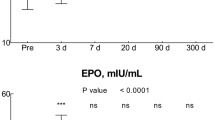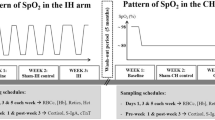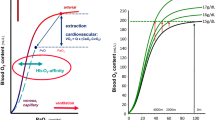Abstract.
While it is well established that highlanders have optimized their oxygen transport system, little is known about the acclimatization of those who move between different altitudes. The purpose of this study was to establish whether the acclimatization to long-term intermittent hypoxic exposure in members of the Chilean Army who frequently move from sea level to 3,550 m altitude is correlated with acute acclimatization or chronic adaptation to hypoxia. A group of officers was exposed intermittently to hypoxia for about 22 years (OI, officers at intermittent hypoxia) and a group of soldiers for 6 months (SI, soldiers at intermittent hypoxia). Both groups were compared to residents at altitude (RA) and to soldiers at sea level (SL). When compared to SL, we observed an 11% increase in total hemoglobin mass (tHb) as well as a corresponding increase in red cell volume (RCV), hemoglobin concentration and hematocrit in all three groups at altitude. Plasma volume (PV) and blood volume (BV) decreased at altitude but increased when OI and SI returned to sea level. Moreover, intermittent hypoxic exposure of OI and SI resulted in increased plasma erythropoietin (Epo) levels, which peaked on day 2 at high altitude followed by decreasing levels during the successive days, and reaching pre-altitude values in SI even when staying at altitude. In conclusion, with regard to tHb and RCV, the acclimatization to long-term intermittent hypoxia resembles the adaptation to chronic hypoxia, while PV and BV regulation mimicked acclimatization to acute hypoxia. Remarkably, finely controlled regulation of Epo expression still occurs after up to 22 years of weekly exposure to altitude.
Similar content being viewed by others
Author information
Authors and Affiliations
Additional information
Electronic Publication
Rights and permissions
About this article
Cite this article
Heinicke, K., Prommer, N., Cajigal, J. et al. Long-term exposure to intermittent hypoxia results in increased hemoglobin mass, reduced plasma volume, and elevated erythropoietin plasma levels in man. Eur J Appl Physiol 88, 535–543 (2003). https://doi.org/10.1007/s00421-002-0732-z
Accepted:
Issue Date:
DOI: https://doi.org/10.1007/s00421-002-0732-z




